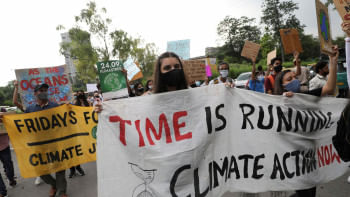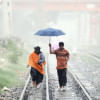Here's how we can beat the heat waves

The world is feeling the scorching heat this summer, with heat waves sweeping across several countries in Europe and Asia. Miles after miles of forests are burning. All living beings are affected by the extreme temperature – there have even been cases of people dying from it.
Heat waves are a manifestation of major climate change impacts, just like increased floods, cyclones, droughts and other natural calamities. Scientists see this as the result of global warming, which is caused by human activities. To carry out economic activities, countries have depended heavily on the extraction and use of natural resources and fossil fuels. In recent years, the climate has changed quite rapidly, according to the sixth assessment report (AR6) of the Intergovernmental Panel on Climate Change (IPCC). The AR6 has further warned that heat waves and humid heat stress will be more intense and frequent this century.
Analysing temperature data, the World Weather Attribution (WWA) suggests that India and Pakistan are 30 times more likely to face deadly heat waves due to climate change. Bangladesh, too, experiences hot weather during a substantive period of the year – longer than what used to be decades ago. The rising temperature has created challenges for human health – the mortality and morbidity due to heat-related causes pose serious concerns. The high temperature is also affecting economies adversely.
However, the impact of climate change falls on people disproportionately. The poor and underprivileged people who work outdoors during the day are the worst hit. Farmers, day labourers, rickshaw-pullers, construction workers and street vendors have no choice but to work for their livelihoods despite the heat. This has a toll on their health and productivity, which in turn affect their income. City dwellers are suffering from low productivity, exhaustion, and heat stroke, living in congested, multi-storey buildings, and without greenery and waterbodies. More and more people are getting dependent on air conditioners, which guzzle high amounts of electricity and also cause greenhouse gas (GHG) emissions. Schoolchildren who use public transport to travel to and from school are also affected by the scorching heat and are vulnerable to health risks.
All these can be prevented. Human lives, livestock, and wildlife can be saved if appropriate and timely measures are put in place. Economic losses due to extreme heat can also be reduced through mitigation and adaptation measures. The existing mitigation and adaptation measures should incorporate preventive actions for heat and other weather-related shocks. Such measures are required at three levels: global, national, and individual.

Since the fossil-fuel-dependent economic activities of developed economies are the biggest cause of climate change, major commitments to finding ways to tackle it will have to come from them. To this end, countries made commitments towards achieving a net zero emission target by the middle of the 21st century at the 26th UN Climate Change Conference (COP26) held last year.
Unfortunately, while the heat waves are becoming more frequent, the European countries' demand for energy is also increasing. What's worse is that, in the wake of the oil crisis due to the Russia-Ukraine war, several European countries are planning to go back to coal-based power generation, which is a major departure from their COP26 commitments. Last month, Germany announced plans to revive its old coal-fired power plants in view of reduced gas supply from Russia. Later, Austria, Italy and the Netherlands also said they would go back to using coal to generate power. European countries are worried about the upcoming winter when they would need higher energy reserves to keep their people warm.
It has been established by the IPCC time and again that the business-as-usual consumption pattern of fossil fuel will not help the world to reach its goals of capping the global temperature rise at 1.5 degrees Celsius. Therefore, the decision to fall back on coal is worrying, since it can have implications on climate commitments. This will imply that the extreme climate events will become common and continue to stay for prolonged periods. This could also have long-term implications. Though some world leaders have assured the situation would not affect the achievement of their climate targets of net zero emission, one cannot be blamed for being apprehensive considering the dependence on dirty fossil fuel.
At the national level, Bangladesh needs to have a heat action plan. Such a plan should have an improved warning system to alert people of an oncoming heat wave threat. Awareness should be raised among people about the effects of exposure to extreme heat. Some basic facilities, such as easy access to drinking water and raising awareness, can be made easily accessible. Time adjustments for work and schooling during hot summer days can give some respite to people and children.
Bangladesh has its Climate Change Strategy and Action Plan, which spells out detailed plans to address climate change through both mitigation and adaptation measures. Before COP26, Bangladesh submitted its Intended Nationally Determined Contribution (INDC) with the commitment to reduce GHG emissions by 6.73 percent by 2030 in five sectors: namely power, transport, industry, waste, and land use. With additional finance and technology from external sources, Bangladesh can reduce its GHG emissions by 15.12 percent.
To ensure agricultural production during extremely hot weather, the country must go for rainwater conservation. Bangladesh uses groundwater for crop cultivation. Such practices should be changed, and we should learn how to use less water and save rainwater. Though such measures are suggested in the climate plan, there is yet no progress on their implementation. The government should take measures immediately to ensure sustainable agriculture and food security during periods of extreme weather events. Other measures such as afforestation, cleaning waterbodies, and banning unfit vehicles on the streets are also very important.
Given the severity of the problem, people also have their parts to play towards combating climate change by changing their behaviours and lifestyles. A collaborative approach is needed for risk management and adaptation strategies. All stakeholders, including the private sector, NGOs, community-based organisations and the general public should be engaged by the government so that they own the responsibility to overcome the challenges of climate change.
Dr Fahmida Khatun is the executive director at the Centre for Policy Dialogue (CPD). Views expressed in this article are the author's own.

 For all latest news, follow The Daily Star's Google News channel.
For all latest news, follow The Daily Star's Google News channel. 










Comments